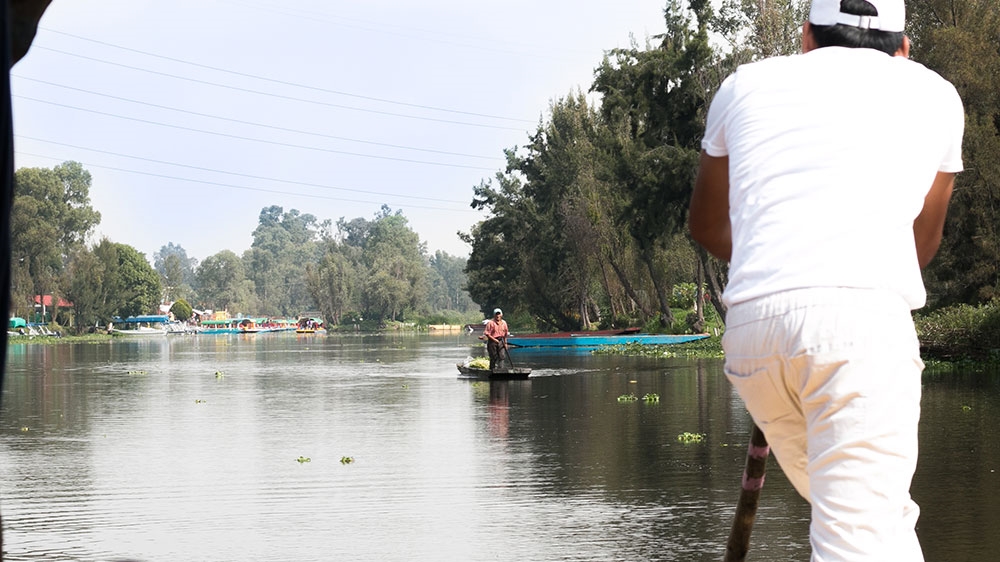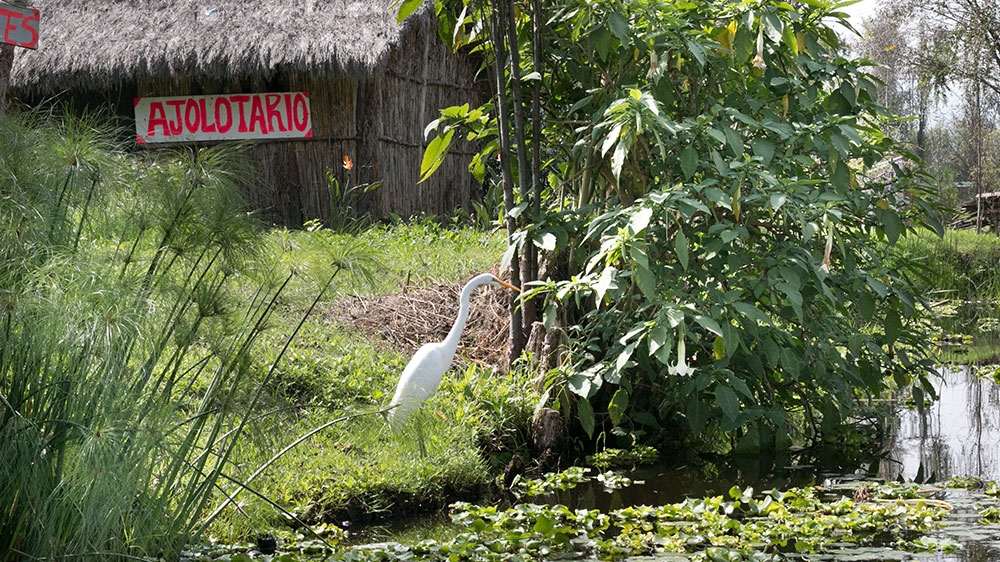Keeping Aztec farming traditions alive in Mexico
Xochimilco, Mexico City – Pedro Capultitla remembers when he was a child, running through his family’s black pastures, a string in hand and a kite gliding above. Canals, canoes and native flora surrounded the ancient patch of farmland. Soft beneath his feet, the fields felt like home.
Three decades later, Capultitla stood on the canal-edge of his family’s chinampa, a man-made island formed for crop growing. Chinampas date back to pre-Hispanic times in Mexico City’s Xochimilco neighbourhood.
Xochimilco sits some 25km south of the city centre today, but it was once the agricultural hub of the Aztec capital Tenochtitlan.
As butterflies flitted among rows of kale, 36-year-old Capultitla pinched off a leaf of kale and flipped it to reveal a small cluster of yellow butterfly eggs. Pointing to them, he exuded pride as he explained that they indicate the farm’s abstention from pesticide use.
Following in his family’s footsteps, Capultitla has taken on the tradition of farming atop the last remaining portion of what was once the enormous Lake of Texcoco, where the Aztecs built their capital city.
 |
| Butterfly eggs on a kale leaf [Paul Biasco/Al Jazeera] |
Like a time capsule from the Aztec period, the gardens rest in the district of Xochimilco. But the tradition is gradually eroding under the weight of the market, tourism and climate change.
The introduction of new agricultural technology, excessive groundwater extraction and abandonment of lands threaten the chinampa system, according to UNESCO.
As a boy, Capultitla never imagined he would eventually return to the fields to make a living. His brother left for the city, as have the descendants of thousands of other chinampa farmers over the last 20 years.
“My dad told me, ‘Go and try to work for companies to see how they treat you there with a schedule of when to enter and when you have to leave. Here you can be your own boss and have your own schedule,'” Capultitla said.
He has been farming on his family’s chinampas for the past 25 years but took a major step this year to expand his fields.
“Our family is very well known for the chinampas,” he said, explaining that he feels “very good” about keeping the tradition alive.
Capultitla’s grandfather owned and farmed five chinampas but, in more recent years, his father scaled back the family plots to one small island owing to his diabetes. Earlier this year, Capultitla decided to bring back to life three of those plots with the help of another farmer.
Capultitla estimates that he is just one of some 100 chinampa farmers who continue to practise traditional farming methods, as compared with 15 years ago, when there were still around 2,000 farms on the islands.
Oral tradition
Completely organic, Capultitla’s farm thrives due to the nutrient-rich soil dug up from the canal and added to each chinampa, preventing erosion and fertilising the land.
The plots can produce seven harvests a year, providing traditional pre-Hispanic produce such as beans, lettuce, cilantro, quintoniles, chard, tomatoes, amaranth, flowers and radishes.
 |
| Aztec farming traditions [Paul Biasco/Al Jazeera] [Daylife] |
The chinampas once provided for the 1.5 million Aztecs in Tenochtitlan. They built their capital city on an island around the year 1300 and, at the time, the only answer to providing the enormous population with sustenance was to build man-made plots of farmland atop the lake.
The chinampas can only be reached by boat, and most of the wooden boats are motorless, powered by hand with long poles stuck into the mud-bottomed canal to propel them forward.
The art of building the land masses was never codified in text or studied in school. Rather, the knowledge has been orally passed down from generation to generation. Capultitla’s constitutes the sixth generation of his family to continue the practice.
“The technique is passed from generation to generation. There is not a book that contains this information,” said Laura Villagrán Vázquez, a biologist who studies and specialises in the chinampas. “It is very important to maintain this knowledge.”
 |
|
The chinampas can only be reached by boat, and most of the wooden boats are motorless [Paul Biasco/Al Jazeera] |
Building chinampas starts with filling an area with mud from the bottom of the lake and organic matter until the new farmland rises above water level.
Then, the chinaperos plant huejotes or Bondpland willows along the edges of the land to create a barrier. Known for holding water and resisting rot, the trees’ roots burrow deep into the earth and anchor the chinampa to land.
Each time Capultitla prepares to plant new seeds, he removes mud from the bottom of the channel and creates a bed of mud next to the canal. He then cuts that mud into small squares.
The following day, he makes holes in each square with his fingers and places a seed in each hole to germinate for three to four days. After that, he prepares the land further inland and transplants the crops.
In a single chinampa, he can fit between 3,000 and 10,000 plants, depending on the season and size of the plants.
Battling the stigma
Capultitla’s favourite parts of the process are harvesting and eating his own produce. “I like to compare it with the Central de Abasto,” he said, referring to the city’s enormous central market. “The flavour [of the produce] from other places is sour, and here the flavour of the products is sweet.”
In past decades, city-dwellers had thought chinampas produce was dirty and tainted by bacteria, largely owing to its origins in the muddied waters, said Villagran Vazquez, who helps farmers prepare their products for commercial use.
But Villagran Vazquez had the waters tested in a lab and found that the bacteria levels in the canal paled in comparison to drinking water in cities. “I had to explain to people that the water is not contaminated,” she said.
In recent years, new initiatives began, aiming at connecting the farmers to restaurants and consumers. One such project, Yolcan, was founded in 2011 and has since supplied produce to some of the most renowned restaurants in Mexico City, such as Pujol, Maximo Bistrot and Quintonil.
 |
| Capultitla estimates that he is just one of some 100 chinampa farmers who continue to practise the traditional farming methods [Paul Biasco/Al Jazeera] |
Xochimilco accounts for nine percent of Mexico City and contains 18km of canals. Only around three percent of the remaining chinampas are used for traditional farming, while others are now used for cattle grazing and even used by football teams that travel to and from practice by boat.
The area, microscopic on a global scale, contains two percent of the world biodiversity and 11 percent of the national biodiversity, according to Villagran Vazquez.
Although this sprawling pre-Hispanic site has gained international notoriety by being named a UNESCO World Heritage Site, tourists and locals alike are more likely to know the district for its popular parties in colourful boats that cruise along the canals with mariachi bands on board.
Ninelth Sandoval runs the Mexico Underground tour company, which aims to highlight traditional Mexican cultural experiences for tourists. Along with her partner, she has shifted the focus of their tours to chinampas instead of parties.
“We are now again starting to feel proud as Mexicans,” Sandoval said. “People used to feel ashamed of our roots. It is very important to remember the ways of our ancestors.”
For his part, Capultitla hopes to pass on to his 12-year-old son a sense of pride in preserving their 1,000-year-old traditions. The boy has already shown interest in farming with his father and studies agriculture in school.
“I will let him make his decision like my father did for me,” Capultitla concluded.
 |
|
Building chinampas starts with filling an area with mud from the bottom of the lake and organic matter until the new farmland rises above water level [Paul Biasco/Al Jazeera] |




